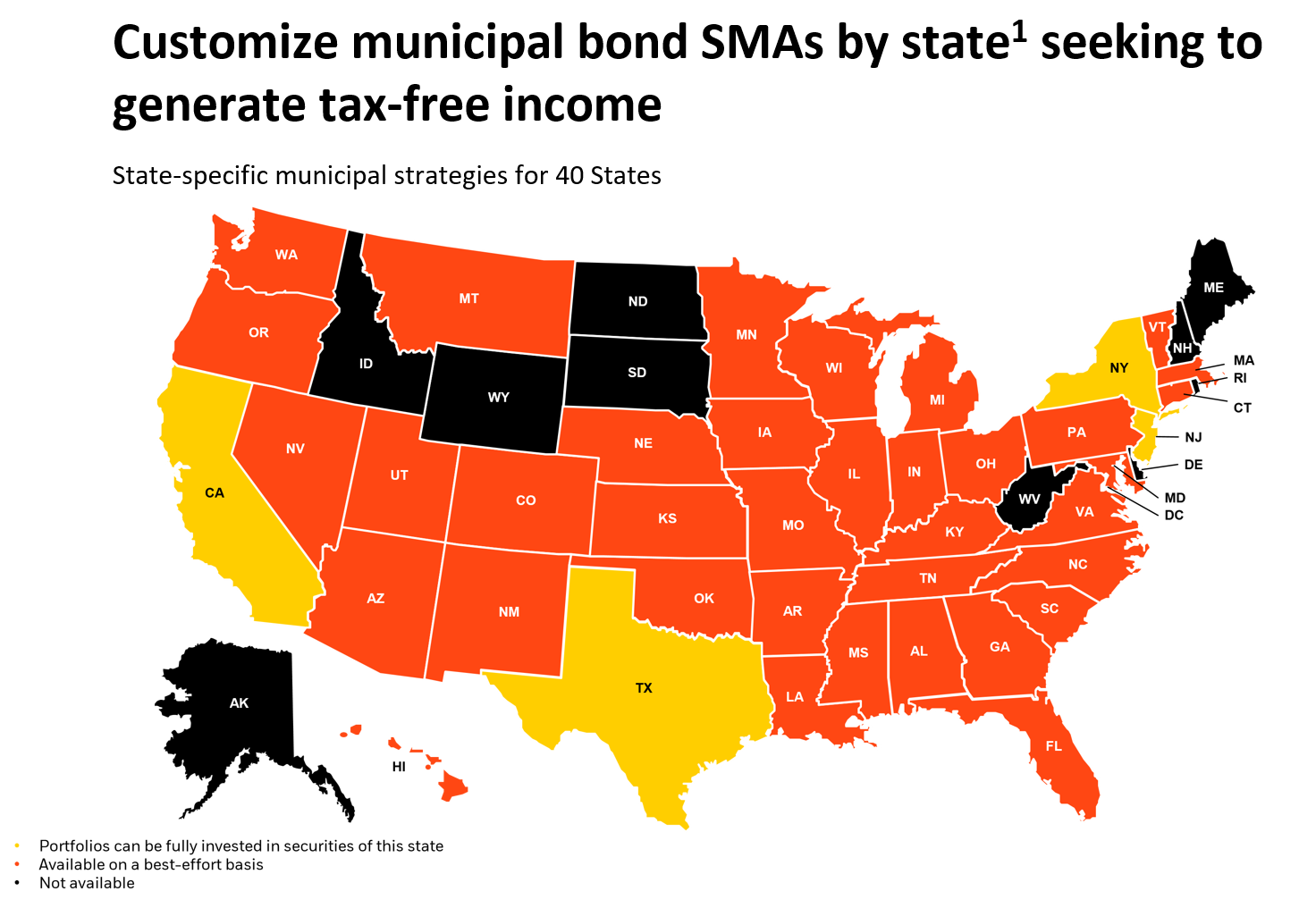Script for video: SMA 101
Slide 3
A separately managed account, also known as an SMA, is a professionally managed portfolio of individual securities.
Slide 4:
SMAs are unique to each investor, providing a wide range of capabilities to advisors and their clients. Regardless of your investment goals or values, SMAs provide greater voice over how a portfolio is constructed and managed.
Slide 5:
Separately managed accounts can provide investors with many of the benefits available through exchange-traded funds and mutual funds, including diversification and professional management. A key difference is what you own as the investor.
Slide 6:
With mutual funds or ETFs, investors own shares of the fund, not the individual securities inside of it.
Slide 7:
SMAs seek to provide similar investment exposure as mutual funds and ETFs, but instead of owning a share of the fund, an investor owns all of the securities inside of the account, putting them at the center of the portfolio.
Slide 8-10:
This unique ownership style introduces a high degree of flexibility and control in portfolios. There can be many benefits to using SMAs, but they are best defined by their inherent ability to provide personalization and tax-management.
Slide 11:
Let’s start with personalization. Because each client owns the securities in their account, every portfolio is unique and may be customized to their specific preferences.
Slide 12:
Clients portfolios can be personalized in a variety of ways. Fixed income investors can customize around duration, credit quality or state specificity, while equity investors can customize for factor tilts, sector exclusions or values-alignment. Regardless of the situation, SMAs empower investors to voice their priorities across the whole portfolio with added levels of transparency.
Slides 13:
Taxes remain one of the biggest challenges that investors face. For clients seeking to keep more of what they earn, individual security ownership through SMAs offer unique tax benefits, beginning when an investor funds an account and continuing on an ongoing basis.
Slide 14-15:
Funding the portfolio is typically the first step in the SMA journey. SMAs provide the flexibility to fund accounts with existing securities, allowing investors to shift portfolios to a new strategy….
Slide 16-17:
…without the tax cost of liquidating highly appreciated securities. Advisors can then work with their investment manager to fill out the portfolio in accordance with their clients’ objectives.
Slide 18:
Ownership of individual securities also allows for continuous tax-loss harvesting. Losses realized in an SMA flow through to the investor’s tax return. The realized losses offset realized gains, decreasing taxes paid at the end of the year.
Slide 19:
When it comes to SMAs, there is no one-size-fits-all strategy. Advisors should work with their clients to develop a plan tailored to their specific goals and objectives.
Slide 21:
[Read each of three recap points]
SMAs are not suitable for every investor. Other investment vehicles may provide the same or similar benefits as separately managed accounts, possibly at a lower cost. Consult with your financial advisor to determine whether an SMA is right for you.
Disclosure language:
Investing involves risk, including possible loss of principal. Asset allocation and diversification may not protect against market risk, loss of principal or volatility of returns. Actual investment outcomes may vary. There is no guarantee that these investments strategies will work under all market conditions or are suitable for all investors and each investor should evaluate their ability to invest long-term, especially during periods of downturn in the market. No representation is being made that any account, product or strategy will or is likely to achieve profits.
This material is provided for educational purposes only and is not intended to constitute investment advice or an investment recommendation within the meaning of federal, state or local law. You are solely responsible for evaluating and acting upon the education and information contained in this material. BlackRock will not be liable for direct or incidental loss resulting from applying any of the information obtained from these materials or from any other source mentioned. BlackRock does not render any legal, tax or accounting advice and the education and information contained in this material should not be construed as such. Please consult with a qualified professional for these types of advice.
This material is not intended to be relied upon as a forecast, research or investment advice and is not a recommendation or offer or solicitation to buy or sell any securities or to adopt any investment strategy.
Due to the complexity of tax law, not every single taxpayer will face the situations described herein exactly as calculated or stated; i.e., the examples and calculations are
intended to be representative of some but not all taxpayers. Since each investor’s situation may be different in terms of income tax, estate tax, and asset allocation, there
may be situations in which the recommendations would not apply. Please discuss any individual situation with tax and investment advisors first before proceeding.
Taxpayers paying lower tax rates than those assumed or without taxable income would earn smaller tax benefits from tax-advantaged indexing or even none at all compared to those described.
© 2023 Blackrock, Inc. or its affiliates. All Rights Reserved. BLACKROCK and APERIO is a trademark of BlackRock or its affiliates. All other trademarks are those of their respective owners.
What is a separately managed account?
SMAs are portfolios of individual stocks and bonds that BlackRock manages and can customize to align with a client’s particular tax needs and personal values.
Explore BlackRock’s SMA platform
BlackRock provides advisors the solutions to better tailor portfolios to the specific needs of their clients across equity, fixed income, and option overlay strategies.
Paragraph-1,Multi Column Teaser-2,Paragraph-2,Messaging Crosslink-1
Paragraph-3,Image-1,Messaging Crosslink-2
Paragraph-4,Multi Column Teaser-3,Paragraph-5,Messaging Crosslink-3
BlackRock’s direct indexing strategies seek to replicate the returns of an index pre-tax and outperform after-tax. Individual security ownership allows clients to transition their positions in-kind, harvest losses on an ongoing basis, and customize positions to reflect the individuality of the investor. Aperio, BlackRock’s direct indexing provider, has partnered with advisors for over 20 years with two main differentiators.
Schedule a meeting with an SMA specialist
If you are a financial advisor, you can sign in to schedule a meeting with one of our SMA specialists. They can review available SMA strategies, portfolio customization capabilities, and generate client-friendly sample portfolios.
Analyze portfolios with SMAs in the 360° Evaluator Tool
Our 360° Evaluator Tool now allows BlackRock and third-party SMAs to be added to portfolios to provide comprehensive analysis across portfolio characteristics, performance, and risk.
How do SMAs compare to ETFs and mutual funds?
With SMAs, since each client directly owns the underlying stocks and bonds, you get visibility into the underlying securities, greater fee transparency and the ability to customize holdings to align with tax management and values preferences.

*The Cerulli Edge: U.S. Managed Accounts Edition, 3Q23
FAQ’s
-
SMAs create benefits for both end investor and advisors by offering institutional investment management in an account of directly held securities. As a result, advisors of high net worth clients are increasingly adding SMA allocations in portfolios.
Benefits for the End Investor:
- Personalization: direct security ownership allows investors to tailor the holdings in their account to their investment objectives, personal values, and liquidity needs.
- Tax Efficiency: SMAs can be funded in kind with securities to reduce capital gains realization, customized with tax efficient features like state specificity in municipal bonds, and systematically tax loss harvested to offset gains elsewhere in client portfolios.
- Low Cost: SMA fees are often lower than those of mutual funds and can be negotiable for large client relationships.
Benefits for the Advisor:
- Capacity: advisors who adopt SMAs spend less time on research, portfolio management, and trading and more time with clients than peers who retain portfolio management responsibilities.
- Institutional Access: SMAs give advisors the opportunity to deliver institutional risk management, market access, and execution in each client account.
- Client Service: SMA PMs serve as an extension to an advisor’s team. BlackRock’s SMA PMs build client portfolios, conduct client reviews, and provide ongoing reports and analytics to both advisor and investor.
-
SMAs fees are billed monthly or quarterly as a percentage of the portfolio’s NAV. This billing process makes SMA fees more transparent than fund fees which are typically deducted directly from fund NAV throughout the year. SMAs like ETFs are generally lower cost than mutual funds, which may appeal to high net worth investors who qualify for their minimums.
-
SMAs are available through SMA or Unified Managed Account (UMA) platforms from broker dealers, custodians, and TAMPs across the wealth management industry. While each platform is unique, every SMA falls into one of two categories:
Dual Contract: the SMA manager signs a direct contract with both advisor and client. This structure enables high levels of account customization and pricing flexibility, but may be more operationally cumbersome.
Single Contract: the SMA manager signs a contract with the advisor, but not the client. While simpler to onboard, single contract SMAs offer less customization and pricing flexibility. SMAs on UMA platforms are single contract.BlackRock has SMA placement on all major industry platforms. For platform specific availability, please reach out to your BlackRock representative.










